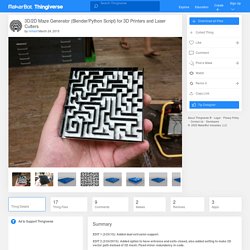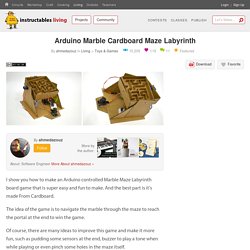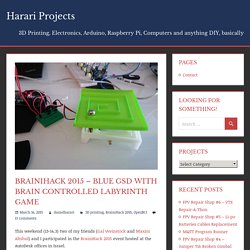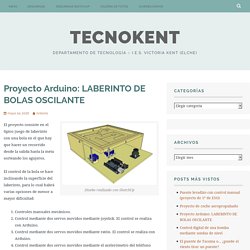

Lazer Maze : 7 Steps - Instructables. Bluetooth Maze : 5 Steps (with Pictures) - Instructables. Maze Game (Arduino Mega + Leds) : 6 Steps (with Pictures) - Instructables. 3D/2D Maze Generator (Blender/Python Script) for 3D Printers and Laser Cutters by nimaid. EDIT 1 (3/24/15): Added dual extrusion support.

EDIT 2 (3/24/2015): Added option to have entrance and exits closed, also added setting to make 2D vector path instead of 3D mesh. Fixed minor redundancy in code. EDIT 3 (3/25/15): Fixed minor settings conflict, added more comments for clarity. So I've had a thing for maze generation for a while. While I wrote a few different games in HTML 5/Javascript and C, I wanted to make something that was actually physically real.
A search on Thingiverse led me to a Python script that generated an OpenSCAD description of a maze, but that seemed too round-about for me. Initially, I wanted to implement it in OpenSCAD, but because it uses a functional language, determined that it was impossible. Laberinto impreso en 3D controlado por su dispositivo Android: 9 pasos (con fotos) - Instructables. Download the imagineering_maze.apk file below on your Android device and follow the instructions at the bottom of this link concerning installation of non-market applications.

If you have no interest in learning how easy it was to create our maze control app or how you can create your own then you can skip the rest of this step. This is our first experience with MIT App Inventor 2 ( AI2 ) but the learning curve was not bad. The code blocks work a lot like the ones in Scratch which we use a lot. AI2 is an online editor that lets you design your apps in your computer browser and test them out on your Android through a wifi connection without having to install each change. To look inside our code, get your AI2 account setup, then download the imagineering_maze.aia file to your computer. From your AI2 projects screen click Projects, select Import project (.aia) from my computer and navigate to the imagineering_maze.aia file (probably in downloads). Siddhesh13/gesture_controlled_maze. Gesture Controlled Maze by sid13.
Gesture Controlled Maze : 8 Steps (with Pictures) - Instructables. I have designed the maze in four different shapes.

You can download it and print it using a single color or multicolor in any color of your choice. Arduino Marble Cardboard Maze Labyrinth : 6 Steps (with Pictures) - Instructables. I show you how to make an Arduino controlled Marble Maze Labyrinth board game that is super easy and fun to make.

And the best part is it's made From Cardboard. The idea of the game is to navigate the marble through the maze to reach the portal at the end to win the game. Of course, there are many ideas to improve this game and make it more fun, such as pudding some sensors at the end, buzzer to play a tone when while playing or even pinch some holes in the maze itself. The Idea I got bored from the electronic game and I started to search about the physical skill games, so I’ve found the Labyrinth and I liked it. What is the Labyrinth? BrainiHack 2015 – Blue GSD with Brain Controlled Labyrinth Game – Harari Projects. This weekend (13-14.3) two of my friends (Gal Weinstock and Maxim Altshul) and I participated in the BrainiHack 2015 event hosted at the AutoDesk offices in Israel.

BrainiHack is a neuroscience themed Hack-A-Thon, where makers come to compete in a day-and-a-half long neuroscience-related project building marathon. My group is called Blue GSD, we are two Communication Systems Engineering students and a Computer Science student. we came with absolutely no background in Neuroscience and tried to make something awesome. We brought an arsenal of tools, electronic components and a home-built 3D Printer. We ended up winning the special OpenBCI prize for the best project in the open source category. The prize was an OpenBCI Starter Kit valued at 500USD. Proyecto Arduino: LABERINTO DE BOLAS OSCILANTE – TecnoKent.
El proyecto consiste en el típico juego de laberinto con una bola en el que hay que hacer un recorrido desde la salida hasta la meta sorteando los agujeros.

El control de la bola se hace inclinando la superficie del laberinto, para lo cual habrá varias opciones de menor a mayor dificultad: Controles manuales mecánicos.Control mediante dos servos movidos mediante joystick. El control se realiza con Arduino.Control mediante dos servos movidos mediante ratón. El control se realiza con Arduino.Control mediante dos servos movidos mediante el acelerómetro del teléfono móvil. El control se realiza mediante Arduino y su conexión por bluetooth al móvil.
La opción de control elegida ha sido la segunda, realizando el programa con el IDE de Arduino, lo que permite que el juego funcione sin necesidad de tenerlo siempre conectado al ordenador, como pasaría si se programase con Scratch para Arduino. Continúa leyendo (código y vídeo).